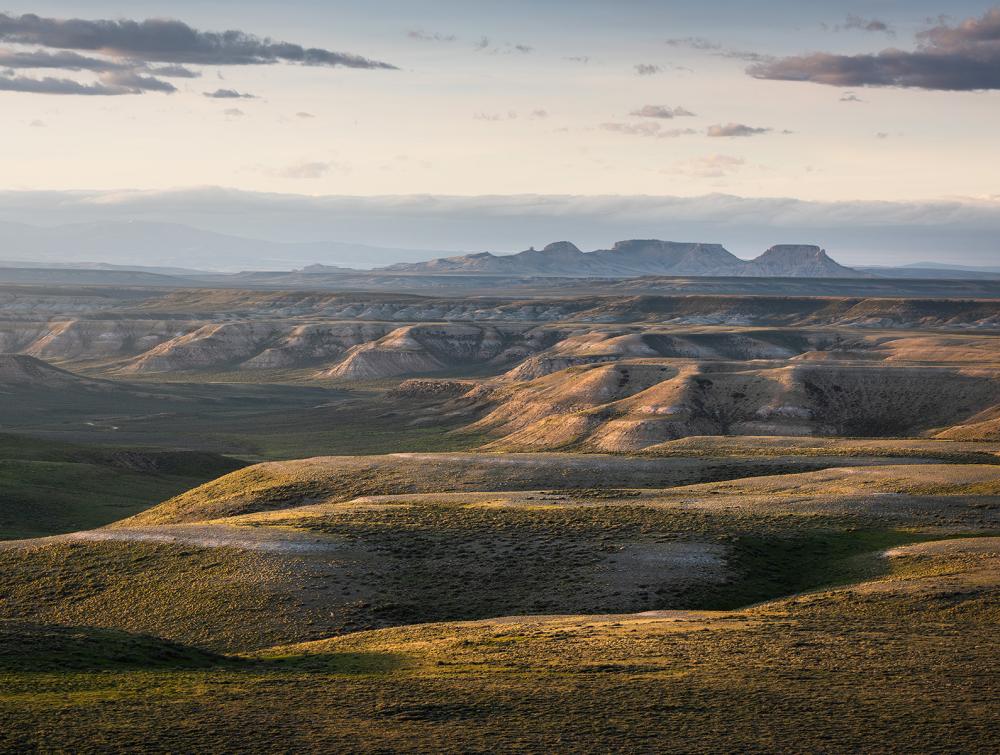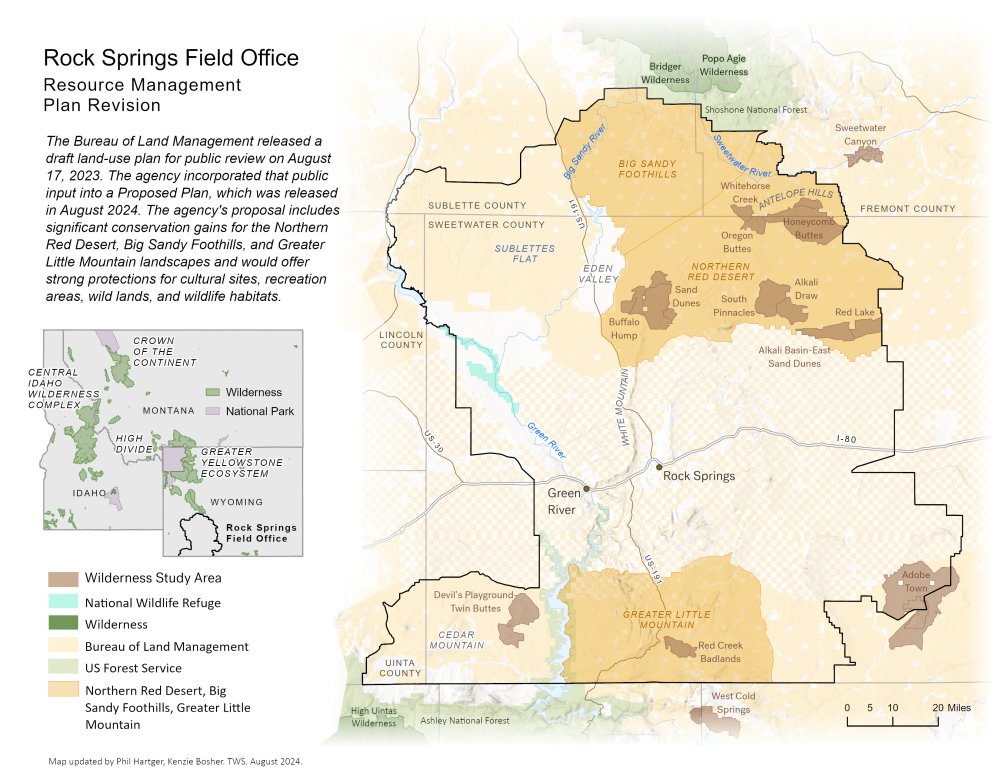BLM’s Rock Springs plan a step forward, conserves lands and habitat

Northern Red Desert
Mason Cummings, TWS
Rock Springs plan reflects public input and conserves key landscapes
The Wilderness Society | Audubon Rockies | Wyoming Outdoor Council | Wyoming Wilderness Association | Sierra Club Wyoming Chapter | Conservation Lands Foundation | Wyoming Interfaith Network
ROCK SPRINGS, Wyo. (Aug. 22, 2024) — The Bureau of Land Management issued its proposed Rock Springs Resource Management Plan, which will ultimately guide forward-thinking management for nearly 3.6 million acres of public land in southwestern Wyoming for the next two decades. The plan includes conservation for important landscapes, including the Northern Red Desert, Big Sandy Foothills and Greater Little Mountain (see map below). These lands are very special to residents of Wyoming and many across the nation, and the much-needed management updates are encouraging. The release of the proposed plan kicks off a 30-day public protest period and a 60-day review period for Governor Mark Gordon.
The following is a statement from Julia Stuble (Wyoming state director for The Wilderness Society) in response to the news:
"We’re heartened to see that the BLM truly listened to public input over the last year and weighed varied interests with such diligence and care. The proposed Rock Springs RMP will help safeguard world-renowned wildlife habitats in the Northern Red Desert and Big Sandy Foothills, plus important cultural areas and hunting, fishing and OHV access. It balances local infrastructure and energy needs with our obligation to steward these special lands for future generations and protect our Wyoming way of life.
We do still have some concerns with the plan. Among other things, the Rock Springs RMP doesn’t adequately protect stopover and highly used portions of big game migration corridors and we believe the Red Desert to Hoback corridor deserves greater recognition. While the plan would largely disallow oil and gas and mining in the Northern Red Desert and Big Sandy Foothills, the entirety of these landscapes should be off-limits. But overall, the plan represents a step toward more holistic and thoughtful management of these public lands. We commend the agency’s professionals for their dedication to working through these complex challenges and urge them to carefully consider how the RMP can be strengthened further between now and when the record of decision is issued.”
Wyoming residents and public lands advocates responded to the plan:
“I treasure the serenity and enlightenment I’ve experienced in the Northern Red Desert while conducting annual bird surveys. I know I’m not alone in feeling passionate about this wild country and the wildlife who call it home. It’s a relief for many of us to know new drilling won’t be allowed in much this area,” said Andrea Orabona, a retired Wyoming Game and Fish Department nongame bird biologist and president of Red Desert Audubon Society. “Hundreds of wildlife species depend on the sagebrush habitats in the Northern Red Desert and Big Sandy Foothills. To ensure the long-term viability of these populations we must limit disturbances, because typically, once habitat has been altered by development, wildlife loses in the end. It’s up to us to ensure that doesn’t happen here, so I applaud the BLM for proposing to conserve this incredible area.”
“It can be challenging to balance economic needs in a mineral-reliant county with preserving wild lands. The BLM has hit the bullseye with this proposal,” said Mark Kot, a retired Sweetwater County public land planner. “The proposed plan acknowledges the long-term needs of the trona industry; chooses low-conflict areas for renewable energy projects and transmission lines; and prohibits speculative leasing and drilling in areas where there’s very low oil and gas potential, like much of the Northern Red Desert and Big Sandy Foothills. With this plan, we can sustain our local communities and maintain the special places we rely on.”
“The Northern Red Desert is a timeless space of spiritual significance where the majesty of creation is revealed. The BLM clearly heard the calls from so many passionate voices who have come together in support of this area,” said The Reverend Annemarie Delgado, Executive Director of Wyoming Interfaith Network. “These wild lands offer spiritual solace in the modern world and deserve safe-keeping.”
“I’m frequently out in the Northern Red Desert with friends, family, and out-of-town visitors and no matter how often we visit, we are stunned by what we see, like abundant wildlife, and what we don’t see, like traffic or many other people. On a recent trip, we watched dozens of pronghorn with their young bounding over the sagebrush and saw sage grouse and other birds. The wildlife have space to breathe out there, and so do we,” said Marjane Ambler, a journalist from Atlantic City, Wyoming. “For years, community members have spoken up in favor of conserving this area, and it’s so satisfying that now the BLM has listened, and everyone who comes after us will be able to experience this iconic Wyoming landscape just like we have: wild and free.”
FURTHER BACKGROUND:
- The Rock Springs RMP covers the Northern Red Desert and Big Sandy Foothills, public lands that range from colorful, craggy buttes to sagebrush flats and desert dunes. These areas contain important habitat and migration corridors for wildlife including elk, mule deer, sage grouse and pronghorn; popular outdoor recreation areas; and areas of immense significance to many Tribal Nations. Community members applauded the conservation BLM proposed for these areas in the 2023 draft plan.
- A former Wyoming State Geologist, Ron Surdam, PhD, and a team of expert geophysicists with extensive experience in the oil and gas plays of western Wyoming analyzed the potential for oil and gas deposits in the Northern Red Desert and Big Sandy Foothill and found that known deposits are insignificant and there isn’t much potential for future discoveries—a finding backed up by the BLM’s own analysis that these area have “low potential” for oil and gas.
- The Rock Springs RMP as proposed would increase protections for cultural sites and lands important to over 30 Tribal nations whose ancestral homelands are in the planning area, including the Eastern Shoshone, Northern Arapaho, Crow, Ute, Southern Ute, Shoshone-Bannock, Cheyenne, Lakota, and others.
- Under the Rock Springs RMP, about a third of the field office, at just over a million acres, would be closed to new oil and gas leasing--mostly areas without significant potential for producing oil and gas. A million acres in the planning area are already leased. In the 2024 Conservation in the West Poll, more than three-quarters of Wyomingites said they support allowing oil and gas drilling only in areas with high production potential.
- In the 2024 Conservation in the West Poll, 69% of Wyomingites said they favor a focus on protecting wildlife migration corridors over new development, and a majority said they support an emphasis on protecting water, air, wildlife habitat and recreation opportunities vs. maximizing the land available for drilling and mining.
- A recent study linked declining productivity of many pronghorn antelope herds in Wyoming to increased oil and gas development. The area covered by the Rock Springs RMP, near the southwest corner of the state, includes land where pronghorn population loss has been especially pronounced, and increased conservation measures, like those included for the Big Sandy Foothills, are sorely needed.
- The Rock Springs RMP would designate 936,193 acres as areas of critical environmental concern (or ACECs), the BLM’s main designation and protected status for places with important natural or cultural value. These ACECs cover much of the Sand Dunes, the area from Steamboat Mountain to the Oregon Buttes, South Pass Historic Landscape and the Big Sandy Foothills.

For more information on the Rock Springs RMP or to talk to policy experts, contact Emily_Denny@tws.org
